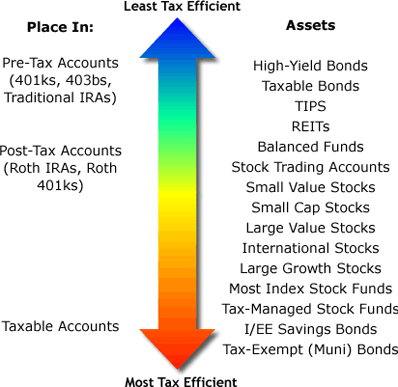SoReady
Recycles dryer sheets
Hi,
I recently went to see my fee only adviser. I do this every couple of years to get input. I think she struggles with my low ER philosophy, but I usually get a nugget or two that is worth the review.
My current portfolio consist of my old 401k, IRA and Roth. My wife just has IRA and Roth. I currently put most, if not all, bond type funds in the IRA portfolio with the Roth's consisting of stock funds. I did this mostly out of reading through this forum. I do have to admit that when trying to rebalance, or even initially balancing with this set up it was difficult.
My adviser has suggested that I stick to my allocation % withing each of the IRA's, Roth's and 401k. Her argument is that it makes withdrawing and balancing going forward much easier. I tend to agree.
Here is my dilemma. In order to do this I will need to consolidate some of the IRA's on my wife's side. She has some in Fidelity, but most in Vanguard. The other issue is that I would then have a % bond allocation within a Roth IRA portfolio.
So I am wondering if most people set up their target allocation across all of the 401k, IRA and Roth's or do you set up your allocation within each e.g. 401k, IRA, Roth, such that each has the same allocation ($Lg cap, %Med Cap, % Intl, %Bond, etc)? If you find an advantage of one way over the other, what is it?
Thanks,
Bob D
I recently went to see my fee only adviser. I do this every couple of years to get input. I think she struggles with my low ER philosophy, but I usually get a nugget or two that is worth the review.
My current portfolio consist of my old 401k, IRA and Roth. My wife just has IRA and Roth. I currently put most, if not all, bond type funds in the IRA portfolio with the Roth's consisting of stock funds. I did this mostly out of reading through this forum. I do have to admit that when trying to rebalance, or even initially balancing with this set up it was difficult.
My adviser has suggested that I stick to my allocation % withing each of the IRA's, Roth's and 401k. Her argument is that it makes withdrawing and balancing going forward much easier. I tend to agree.
Here is my dilemma. In order to do this I will need to consolidate some of the IRA's on my wife's side. She has some in Fidelity, but most in Vanguard. The other issue is that I would then have a % bond allocation within a Roth IRA portfolio.
So I am wondering if most people set up their target allocation across all of the 401k, IRA and Roth's or do you set up your allocation within each e.g. 401k, IRA, Roth, such that each has the same allocation ($Lg cap, %Med Cap, % Intl, %Bond, etc)? If you find an advantage of one way over the other, what is it?
Thanks,
Bob D

